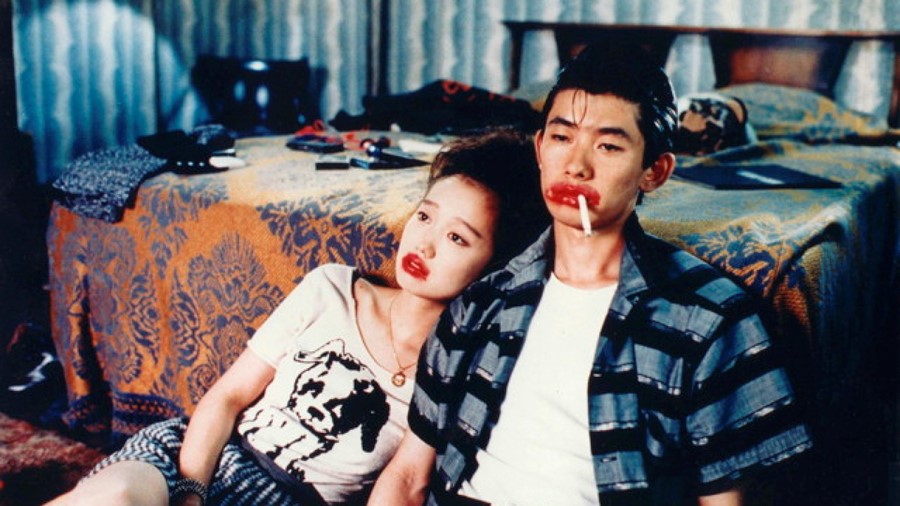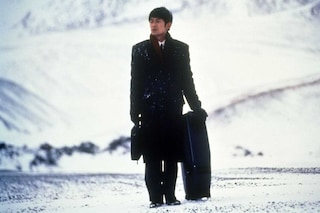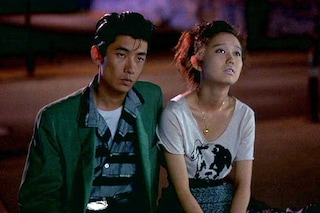The actor worked with every major Japanese filmmaker of his generation, while also making a significant impact in western indie cinema – here, we pick out six of his defining roles
In the late 80s and early 90s, as indie cinema went mainstream in the west, we were spoiled with hot young acting prospects who would define the decade thereafter. River Phoenix was gone too soon after appearing with Keanu Reeves in My Own Private Idaho (Gus Van Sant, 1991). Fresh-faced Johnny Depp and soon-to-be girlfriend Winona Ryder made their mark in Edward Scissorhands (Tim Burton, 1990) – before the former starred alongside teen-aged Leo DiCaprio in What’s Eating Gilbert Grape? (Lasse Hallström, 1993). All the while, everyone from Natalie Portman (Leon: The Professional) to Will Smith (The Fresh Prince of Bel-Air) was fast cementing their stardom in a rich and nostalgic period of dynamic visual entertainment.
Over in Japan, meanwhile, a cinematic renaissance was on the horizon. Japanese movies would strike gold at Cannes and Venice in 1997, as Ring (Hideo Nakata, 1998) kick-started a global boom in J-horror cinema. Kids, meanwhile, ran amok in a wave of juvenile delinquency films, as hyper-violent works like Audition (Takashi Miike, 1999) found their audience overseas. Unsurprisingly, this golden age yielded its own generation of leading stars – and of those, Masatoshi Nagase shone brightly amongst the crowd.
With a career that has latterly encompassed landscape photography, fashion campaigns with Yohji Yamamoto, and pop music (The Prince-inspired “Coney Island Jellyfish” video was directed by Spike Lee’s brother, Cinqué), it’s wild to comprehend that Nagase also managed to collaborate with nearly every major Japanese filmmaker of his generation. “He’s one of the real, unique characters of Japanese cinema,” says Adam Torel of distributors Third Window Films. “There’s not been a person like him or [fellow icon] Tadanobu Asano since.”
Responsible for some of the most recognisable roles and films in contemporary Japanese cinema, says Torel, Nagase would become renowned after appearing in countless off-the-wall projects in the 90s and 00s, while also making an impact in western indie cinema. With Criterion’s re-release of the Jim Jarmusch classic Mystery Train this month – as a series of Nagase-led works arrive via Third Window Films in 2023 – the time seems ripe for the rediscovery of one of Japan’s unsung icons of the era. Read on for a six-film primer.
MYSTERY TRAIN (1989)
In the opening shots of the classic indie triptych Mystery Train, a young Japanese man rides the train to Memphis. He slouches in the cabin, combing slicked-back hair and listening to Elvis Presley, before exiting onto the platform wearing a khaki jacket, oversized belt buckle and black creepers alongside his girlfriend (Yûki Kudô). With a cigarette perched behind his ear, Jun (Nagase) is the embodiment of the movie’s timeless cool; a defiant young renegade on a pilgrimage to a music mecca in the heart of rundown America.
With a cast that elsewhere features Steve Buscemi, Screamin’ Jay Hawkins and The Clash’s Joe Strummer, it’s quite a feat that this unknown duo would become Mystery Train’s most iconic characters, immortalised by poster images of them smeared in lipstick in the film’s central dilapidated hotel room. The film – a whiskey-stained tour of Sun Studios and its shabby surroundings – meanwhile, competed for the Palme d’Or at Cannes in 1989, winning the Best Artistic Achievement Award in the process.
Off the back of the film’s cult success, Nagase – erstwhile known only for roles in a handful of 80s teen comedies in Japan – would be set on the path to stardom. Years later, Jarmusch would cast him once again, with Nagase playing the Japanese poet opposite Adam Driver’s dejected bus driver in Paterson (2016).
THE MOST TERRIBLE TIME IN MY LIFE (1994)
After winning two Japanese Academy Awards in 1992 – for playing a young man who falls in love with a deaf-mute factory girl in Yoji Yamada’s My Sons – Nagase was cast as private eye Maiku Hama in the first of a series of stylish noirs initially helmed by director Kaizo Hayashi.
In The Most Terrible Time in My Life, Hama is introduced in a run-down office in the projection room of a film theatre – but before long, he’s on the streets, smoking cigarettes in blacked-out shades and driving a vintage Nash convertible. After losing his pinkie in a restaurant bust-up, the hapless detective takes on a case for the establishment’s Taiwanese waiter, whose brother is missing. Soon, he’s embroiled in the middle of a gang war.
It’s director Hayashi’s slick style that makes The Most Terrible Time in My Life so distinctive. His New Wave-inspired visual work, built on monochromatic cinematography and impressionistic lighting, makes gun-toting thugs and PI veterans (played by icons like Tetsuo: Iron Man director Shinya Tsukamoto and 70s hardman Joe Shishido) bounce off the screen. Two sequels followed ahead of a Nagase-fronted TV series in the early 00s, with episodes of The Private Detective Mike Hama directed by leading filmmakers like Shinji Aoyama (Eureka), Tetsuya Nakashima (Confessions), Isao Yukisada (Go) and Sogo Ishii (Crazy Thunder Road).
COLD FEVER (1995)
In Japan, anonymous salaryman Hirata (Nagase) is caught up in the never-ending rat race. He works for a fish sales firm, reluctantly karaokes with his boss, and lives an otherwise unremarkable life as he saves up for a dream golfing holiday in Hawaii. But his plans change when his grandfather (a cameo from veteran filmmaker Seijun Suzuki) decrees that Hirata should venture to Iceland to perform memorial rites for his parents, who died there seven years ago.
Against backdrops of snowcapped mountains, icy plains and endless tundra, Hirata finds himself venturing into a “very strange country” inhabited by carol-singing taxi drivers, psychic bar patrons and eccentric American tourists (including Succession’s Fisher Stevens). But of course, it’s the journey that counts in this quirky road comedy from director Friðrik Þór Friðriksson and American indie producer Jim Stark (Mystery Train; The Doom Generation) – which, two decades after its release, was named one of ‘10 Great Icelandic Films’ by the BFI.
PARTY 7 (2000)
Miki (Nagase, sporting leather slacks and killer sideburns) is hiding a briefcase full of money at the ‘Hotel New Mexico’. Unfortunately for him, the place is choc-a-bloc with eccentric guests. Among them: his ex-girlfriend, a self-conscious hotel porter and, in a neighbouring room replete with blue velvet furniture, a nerdy young man (Tadanobu Asano, Ichi the Killer) who watches proceedings alongside the enigmatic ‘Captain Banana’ (Yoshio Harada, Still Walking; 9 Souls). These characters’ curious interactions and arguments will carry this absurd crime-comedy, as the fate of the missing money hangs over them.
Featuring eye-popping costumes, striking production design, and a scintillating animated sequence set to bustling breakbeats, this absurd comedy from director Katushito Ishii (Funky Forest) marks a conducive companion piece to the director’s cult 1998 debut Shark Skin Man and Peach Hip Girl. The quirky double bill – which impressed Quentin Tarantino enough that he hired Ishii to direct the animated sequence in Kill Bill: Volume 1 in 2003 – screens at the Prince Charles Cinema in London in July 2023, with the cult filmmaker in attendance for a rare UK event ahead of a box-set release via Third Window Films.
ELECTRIC DRAGON 80,000v (2001)
In 1989, the role of Jun (Nagase)’s girlfriend in Mystery Train was cast after Jim Jarmusch saw actress Yûki Kudô in Sogo Ishii’s 1984 offbeat comedy The Crazy Family. Years later, Nagase himself would become a favourite of the celebrated punk filmmaker, who would cast him opposite frequent co-star Tadanobu Asano in films like Gojoe (2000), Dead End Run (2003) and Punk Samurai (2018).
Nagase’s most memorable collaboration with Ishii, though, came in 2001, when he played masked, electricity-wielding vigilante Thunderbolt Buddha in the 55-minute punk schism Electric Dragon 80.000v. The explosive, guerilla-style indie film (shot in freezing conditions, as the director recalled in an interview with Dazed earlier this year) would see him showdown against “reptile investigator” Dragon Eye Morrison (Asano) on the rooftops of Tokyo. It’s all set to the sound of blistering industrial guitars and feedback, ensuring a truly brain-frazzling experience.
SUICIDE CLUB (2002)
“Extreme” Japanese cinema was truly in vogue by the early 00s, as films like Takashi Miike’s Audition (1999) and Kinji Fukasaku’s Battle Royale (2000) caused a stir on an international scale. Capitalising on the phenomenon was arch-provocateur filmmaker Sion Sono (last seen directing Nicolas Cage in absurd samurai-western Prisoners of the Ghostland in 2021), who cast a mullet-sporting Nagase in a central role in his controversial J-horror classic Suicide Club.
The film opens with one of the most shocking scenes in contemporary cinematic history, as 54 high school students partake in a mass suicide event at a crowded train station. It’s a bloodbath. And as similar events begin to occur all across the country, it’s up to detectives Kuroda (Ryō Ishibashi, Audition), Murata (Akaji Maro, The Most Terrible Time in My Life) and Shibusawa (Nagase) to work out why. The denouement is bizarre (typical of works by this iconoclastic filmmaker), but the film’s notoriety is well-earned.
Join Dazed Club and be part of our world! You get exclusive access to events, parties, festivals and our editors, as well as a free subscription to Dazed for a year. Join for £5/month today.







